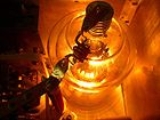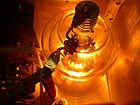
4-1000A
Encyclopedia

Specifications
The 4-1000A is a relatively large glass tube with an overall height of 9.25 inches and a diameter of 5 inches. It is designed to operate with its plate at an orange-red color due to the "getter" being a zirconium compound on the anode structure which requires a great deal of heat to be effective. The cathode is a directly-heated, thoriatedThorium
Thorium is a natural radioactive chemical element with the symbol Th and atomic number 90. It was discovered in 1828 and named after Thor, the Norse god of thunder....
-tungsten filament rated at 7.5 volts at 21 ampere
Ampere
The ampere , often shortened to amp, is the SI unit of electric current and is one of the seven SI base units. It is named after André-Marie Ampère , French mathematician and physicist, considered the father of electrodynamics...
s. Connections to the filament and grids are made via a special 5-pin socket, and the anode connection is at the top of the tube.
The tube may be operated as a class C amplifier in which a single tube can provide up to 3340 watts of RF power. A pair of tubes may be operated as an audio-frequency modulator for an AM transmitter; in this case a pair of tubes will provide up to 3,840 watts of audio power.
Internal construction
The 4-1000A is of radial construction; the most obvious feature is the large, roughly cylindrical, blackish anode suspended from the top of the tube. The anode, which may be constructed out of metal or graphite, is finned for increased power dissipation. The filament and grids are supported from the lower section/base of the tube.History
The 4-1000A was available from multiple manufacturers including RCA and EIMAC, AMPEREX, and Triton.Cooling
A complete cooling system is required to operate the tube at rated values. A centrifugal fanCentrifugal fan
A centrifugal fan is a mechanical device for moving air or other gases. It has a fan wheel composed of a number of fan blades, or ribs, mounted around a hub. As shown in Figure 1, the hub turns on a driveshaft that passes through the fan housing...
pressurizes the equipment chassis
Chassis
A chassis consists of an internal framework that supports a man-made object. It is analogous to an animal's skeleton. An example of a chassis is the underpart of a motor vehicle, consisting of the frame with the wheels and machinery.- Vehicles :In the case of vehicles, the term chassis means the...
and provides a continuous stream of cooling air. A specially designed socket is used to direct the air over the filament and grid connections, and a glass chimney (Pyrex®) then directs the air around the tube's glass envelope; chassis-mounted metal clips are used to center the chimney around the tube. Finally, a finned, cylindrical heat sink
Heat sink
A heat sink is a term for a component or assembly that transfers heat generated within a solid material to a fluid medium, such as air or a liquid. Examples of heat sinks are the heat exchangers used in refrigeration and air conditioning systems and the radiator in a car...
is attached to the anode connection (top of the tube) to provide additional cooling for the anode's glass-to-metal seal.

